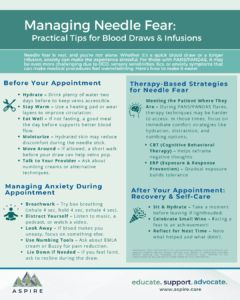Needle fear is real, and you’re not alone. Whether it’s a quick blood draw or a longer infusion, anxiety can make the experience stressful. For those with PANS/PANDAS, it may be even more challenging due to OCD, sensory sensitivities, tics, or anxiety symptoms that can make medical procedures feel overwhelming. Here’s how to make it easier.
Download ASPIRE’s Managing Needle Fear:
Practical Tips for Blood Draws & Infusions
Before Your Appointment: Set Yourself Up for Success
✅ Hydrate Well – Start drinking plenty of water at least two days before your procedure. Dehydration can make veins smaller and harder to access, increasing the risk of rolling or collapsing veins.
✅ Eat a Balanced Meal – Eating well the day before can improve blood flow, but if you’re fasting, avoid food, drinks (except water), strenuous exercise, and tobacco products for at least eight hours before your blood draw (unless instructed otherwise by your doctor).
✅ Stay Warm – Warmth increases circulation, making veins easier to find. Use a heating pad on your arm for a few minutes before the procedure or keep a jacket on while waiting.
✅ Moisturize – Applying lotion a few times a day in the days leading up to your procedure can make the skin more pliable, which may help reduce discomfort during the needle stick.
✅ Move Around Beforehand – If you’re not fasting, taking a short walk before your blood draw can raise your blood pressure slightly and make veins more visible.
✅ Talk to Your Provider – If you’ve had difficult blood draws before, let your nurse or phlebotomist know. They may use a smaller needle, try a different site, or suggest numbing creams (like EMLA) or vibration tools (like Buzzy).
✅ Consider Long-Term Options – If you need frequent blood draws or infusions and have difficult veins, ask your doctor if a catheter or port could be an option.
During Your Appointment: Managing Anxiety & Discomfort
🧘 Breathwork for Calming – Controlled breathing techniques can help regulate your nervous system and reduce anxiety. Try:
- Box Breathing: Inhale for four counts, hold for four, exhale for four, and repeat.
- 4-7-8 Breathing: Inhale for four counts, hold for seven, exhale slowly for eight.
🎧 Distraction Works – Bring headphones and listen to music, a podcast, or an audiobook.
💭 Use Visualization – Imagine yourself somewhere relaxing, like a beach or cozy spot at home.
🤲 Try Tapping (EFT Therapy) – Lightly tap pressure points while repeating calming statements (e.g., “Even though I feel nervous, I am safe.”)
🙈 Look Away – If the sight of blood makes you uneasy, turn your head and focus on something else.
🛏️ Lie Down if Needed – If you’re prone to fainting, ask if you can recline or lie down for the blood draw.
Therapy-Based Strategies for Needle Fear
For some, needle fear is more than just discomfort—it’s a phobia that can make medical procedures feel overwhelming. When possible, professional therapies like Cognitive Behavioral Therapy (CBT) and Exposure and Response Prevention (ERP) can be helpful.
🚦 Meeting the Patient Where They Are – If you or your child are in an active PANS/PANDAS flare, accessing CBT or ERP techniques may be challenging. In those moments, acute medical needs come first, and managing distress in the moment (through hydration, distraction, numbing tools, or support people) may be the most realistic approach. Therapeutic strategies can be revisited when symptoms stabilize.
🧠 Cognitive Behavioral Therapy (CBT) – Helps patients identify and reframe negative thoughts about needles, making the experience feel less threatening.
🔁 Exposure and Response Prevention (ERP) – A step-by-step approach where patients gradually build tolerance by working up to the procedure in small steps (e.g., looking at a picture of a needle, watching a video, then eventually experiencing a blood draw).
After Your Appointment: Recovery & Self-Care
✔ Take It Easy – If you feel lightheaded, sit for a moment and drink water before leaving.
✔ Celebrate Small Wins – Facing a fear is an achievement—treat yourself to something enjoyable!
✔ Plan for Next Time – Take note of what helped and what you’d like to do differently next time.
Final Thoughts
Vein access can be tricky for many reasons—some people have naturally smaller veins, and others may have age-related changes or medical conditions that make blood draws and IV placement more difficult. However, hydration, warmth, movement, and communication with your provider can all improve the experience.
For those with severe needle fear, CBT and ERP can be effective tools, but it’s important to recognize that during a flare, these techniques may not be fully accessible. In those times, self-compassion and immediate coping strategies take priority.
Needle fear doesn’t have to hold you back. With the right tools and preparation, blood draws and infusions can be more manageable—one step at a time. 💙
Additional ASPIRE Resources
Mastering the Art of Swallowing Pills: A Step-by-Step Guide
Struggling with pill swallowing can be tough, but you’re not alone. With the right techniques, it’s possible to make this part of treatment a little easier for everyone involved. Check out our step-by-step guide for practical tips to help patients and caregivers navigate this challenge. 💊
🔗 Mastering the Art of Swallowing Pills: A Step-by-Step Guide
Hydration & IVIG: Why It Matters
Proper hydration is key when undergoing IVIG treatments. Staying hydrated not only supports overall health but helps ensure the treatment works effectively. Learn why hydration matters for those undergoing IVIG therapy and how it can make a difference in the treatment experience.
🔗 Hydration & IVIG: Why It Matters
Disclaimer: This information is for educational purposes only and should not replace medical advice. Always consult your doctor or healthcare provider before making any changes to your treatment plan. ASPIRE is not responsible for any decisions made based on this information.
